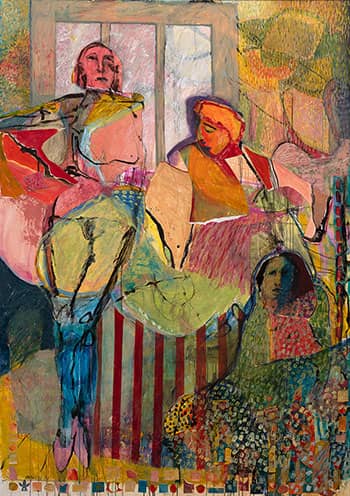
Buderim-based Veronica Cay’s current paintings and ceramic sculptures viscerally document her musings on the conundrums of societal expectations. She imparts that, as always, her focus is from a female perspective. Certain currently accepted rituals seem quite inane to her, given their roots way back in archaic times. The antipasto analogy in the exhibition’s title relates to a preliminary tasting of what’s to come – in this case not a culinary event but a wedding! Cay understands that whilst weddings are considered to be occasions of great celebration, the hectic behind the scenes preparations for such are generally unacknowledged. The bridesmaids are required to be mindful of so many factors, including the expected adherence to outmoded traditions.
the bridesmaid’s antipasto works became a vehicle to explore the multi-faceted nuances of emotions and human behaviours that surround a marriage,” tells Cay. “Historically, in many cultures, marriage was about a union between families or factions to help revive economies and strengthen securities. Matchmakers were employed to find suitable partners, and daughters were raised to become good wives and mothers. This series barely scratches the surface of the huge gamut of narratives that could be explored!”
Cay’s renditions on canvas and paper embrace the figurative expressionist mode. The painted and collaged surfaces have an extraordinary psychological presence. Realistic portrayal is not her concern but rather the arousal of a subliminal, emotional response. Direct brushwork and the distortion of form create pictorial tension, while intense hues and size relationships heighten the drama. “The paintings are always the result of a process,” Cay informs. “They rarely start with identifiable figures. The depictions emerge as the colour, shapes and forms suggest possible compositions and usually change several times before completion. Using collage in the paintings disrupts the surface and reveals a new conversation. I am never sure what the final outcome will reveal.”
“The titles of the paintings all hint at a narrative but these associations are loose,” Cay continues. “They are open-ended and waiting for the viewers to respond with their own memories and experiences – it is after all, such fertile ground.” That being said, wry humour is evidenced in the imagery and title of never underestimate the dressing. She explains that the word ‘dressing’ alludes to both an antipasto salad dressing and to the bride’s attire, or lack of. Judging from the look on her attendant’s faces, they certainly seem to have ‘underestimated’ something.
Robust expressionism also extends to Cay’s ceramic sculptural pieces. The malleability of the raw, white clay medium facilitates endless creative possibilities. As with her paintings, there is no predetermined outcome – not only with the shape modelling but what will eventuate when the engobe embellishments emerge from the kiln. The subjects and their titles again relate to wedding conventions. Cay visualised displaying the sculptures as “an installation where the items formed a still life tableau of gifts and table decorations”.
“wonder woman needs no introduction,” says Cay, “it speaks to expectations of motherhood and domesticity. The female here is positioned upon an ornamental pedestal that is evocative of a cake stand. Beneath the protective folds of her clothing she shelters a child. She appears to have some arrows or tools on her back but from a side view there is a resemblance akin to a blue striped vase of flowers.”
The Victorian era rhyme of ‘something old, something new, something borrowed, something blue’ is evinced in several works. These articles given to the bride before walking down the aisle symbolised: linkages with the past; future good fortune; acquired happiness; purity and fidelity. The ceramic, something old, has pieces of an antique silk quilt attached to the body. Cay mentions that quilts were standard commodities in glory boxes and hope chests.
Other pieces allude to practices from much earlier times. Cay describes the bathing in the May morning dew as loosely drawing on pagan myths and rituals surrounding May Day festivities. It was believed that if a maiden washed her face in morning dew on that day it would reveal her true beauty and thus assist in attracting a future husband. The figure’s intricate, crown-like headdress signifies a connection to the May Queen.
Although the works in Cay’s exhibition convey personal sentiments, she is in no way didactic, “I want there to be a little bit of mystery that invites an interactive communication with the viewer”.
JACQUELINE HOUGHTON
Receive e-mail updates on our exhibitions, events and more
Subscribe Now